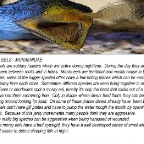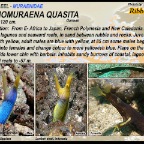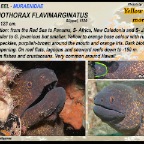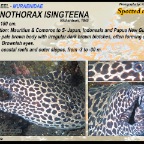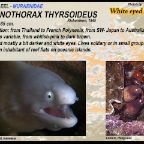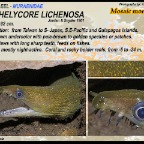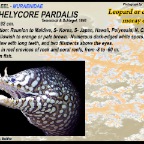MORAY EELS - MURAENIDAE
Moray eels are solitary hunters that are active at night. During the day they are generally seen between rocks and in holes. Moray eels are territorial and typically live in one hole. Some of the bigger species often have a few hiding places which can be many meters apart. Sometimes different species are seen living together in one hole. Usually when divers or snorkelers discover a moray eel it’ll just be the head that is protruding. Rarely do we see them swimming freely. It’s usually only in places where divers feed them, can they be seen swimming around looking for food. On some of these sites divers have been bitten by eels! Eels don't have gill plates and have to pump water through the mouth by opening and closing it. Because of this jerky movement many people think they are aggressive. The really big species can be aggressive though when being harassed or wounded. Because moray eels have bad eyesight they have a well developed sense of smell which makes it easier to detect sleeping fish at night. Length: 65 cm.Distribution: from Thailand to French Polynesia, from SW- Japan to Australia.Colour is variable, from whitish-pink to dark brown. The head mostly a bit darker and white eyes. Lives solitary or in small groups.Common inhabitant of reef flats on oceanic islands. Length: 1,2 m.Distribution: from E. Africa to the East Pacific Isl. to Ryukus and Great Barrier Reef.Small dark spots on a light body, prefers dead corals and stony areas in tidal zones. Feeds on small crustaceans and fish, sometimes leaving the water in pursuit of prey. Small juveniles have circles on the body instead of spots, changes with growth. Length: 50 cm.Distribution: E. Africa to Philippines, Marq. and Society Isl. and Johnston Island.The facial pattern is distinctive. A rusty brown colour with pale spots and scribbled lines. Large white spots next to jaws. Lives between rubble and ledges of seaward reefs, between -8 to -40 m. Hides during the day, usually seen during night time. Length: 120 cm.Distribution: Red Sea and E- Africa to Galapagos Is., S- Japan, Hawaii and Australia.Brown with numerous circular white spots. Inside of the mouth and tail-tip, white.Feeds primarily on fishes, less on crustaceans. In coral-rich areas of lagoons and seaward reefs, from -1 to -36 m. Length: 1,8 m.Distribution: from East Africa and Maldives to the Great Barrier Reef and Japan.Dark brown widely spaced spots on a cream to yellow body, changes a bit with age(of the moray ofcourse). They live solitary, activ during day time. Can be found on outer reef slopes of continental reefs. Warning! Big adult specimen can be agressive. Length: 230 cm.Distribution: Red Sea to Ryukyus, Hawaii, French Polynesia and New Caledonia.Probably the most common large moray in the Indo-Pacific. Brown with irregulardarker brown spots over the whole body, black blotch on gill opening. Mostly seenwith their head sticking out of a hole. In lagoons and seaward reefs, from -1 to -46 m. Feeds on small fishes, sometimes crustaceans. Quite tame but can be aggressive when being annoyed. Length: 123 cm.Distribution: from the Red Sea to Panama, S- Africa, New Caledonia and S- Japan.Very similar to G. javanicus but smaller. Yellow to orange base colour with rusty-brown speckles, purplish-brown around the mouth and orange iris. Dark blotch over the gill opening. On reef flats, lagoons and seaward reefs down to -150 m.Feeds on fishes and crustaceans. Very common around Hawaii. Length: 80 cm.Distribution: from the Red Sea to the Ryukyus, French Polynesia and N- Australia.Green-ish on top of the head, irregular dark-brown to black spots on the body which sometimes form lines. Lives solitary and is active during night time. In lagoons and crevices of outer reefs, from -7 to -50 m. Feeds on fishes and crustacean. Length: 58 cm.Distribution: E- Africa and Gulf of Aden to SW- Japan, Samoa and Australia.White to creamy base colour with brown patches, around 20 dark-brown bars encircling body and fins. These bars are darker on the fins than on the body, nostrils mostly have a yellow edge. Nocturnal, but sometimes out during the day. Juveniles are bright white with black bars. In lagoons and on outer reefs, from -1 to -15 m. Length: 80 cm.Distribution: known from SW- Japan, Philippines and Indonesia.White to cream body with 13 broad dark brown to black encircling bands.Numerous dark spots and blotches on head and other pale areas.Lives solitary, in sand or rubble areas of coastal reefs, from -12 to -30 m.Enters the burrow tail first. Length: 92 cm.Distribution: from Taiwan to S- Japan, S.E-Pacific and Galapagos Islands.Dark brown undercolor with pale-brown to golden speckles or patches.Curved jaws with long sharp teeth, feeds on fishes.Solitary, mostly night-active. Coral and rocky bolder reefs, from -5 to -24 m. Length: 70 cm.Distribution: Red Sea and E- Africa to SW- Japan, Hawaii, Polynesia and Lord Howe. Cream to brown mottled pattern, pale blue ring around the eye’s.Younger specimen with 25 to 30 dark brown bars.Day- and night-active, feeds on small crustaceans.On reef flats, shallow lagoons and seaward reefs, down to -15 m. Length: 100 cm.Distribution: Red Sea & E- Africa to Panama, S- Japan, Hawaii, Micronesia, Lord Howe.A grey and blunt snout with short conical teeth, yellow eyes and nostrils. Two rows of large dark brown to black blotches, whole body covered with irregular shaped black-brown and yellow spots. Feeds primarily on crustaceans. Shallow lagoons and seaward reefs, particularly common on intertidal reef flats.



